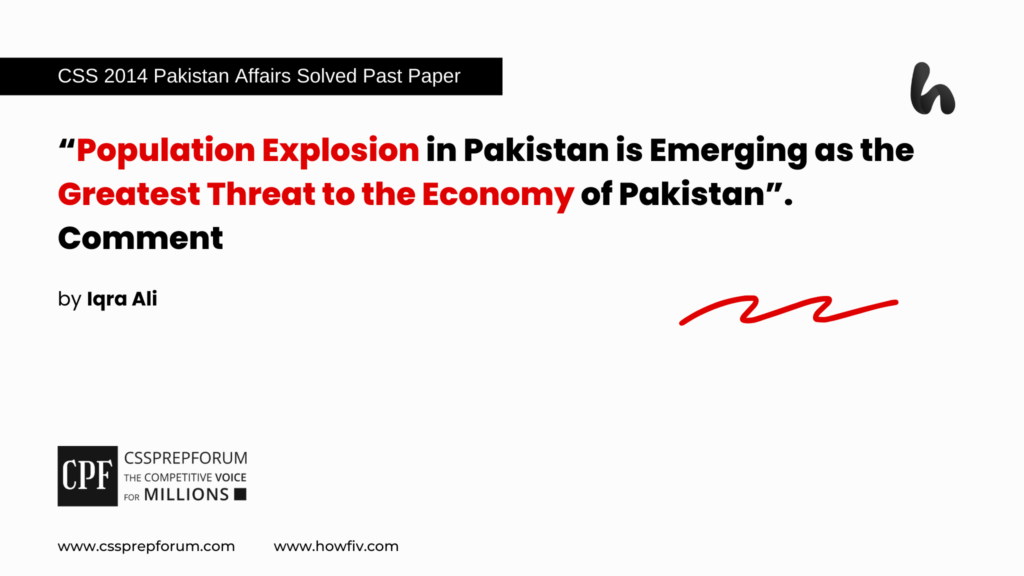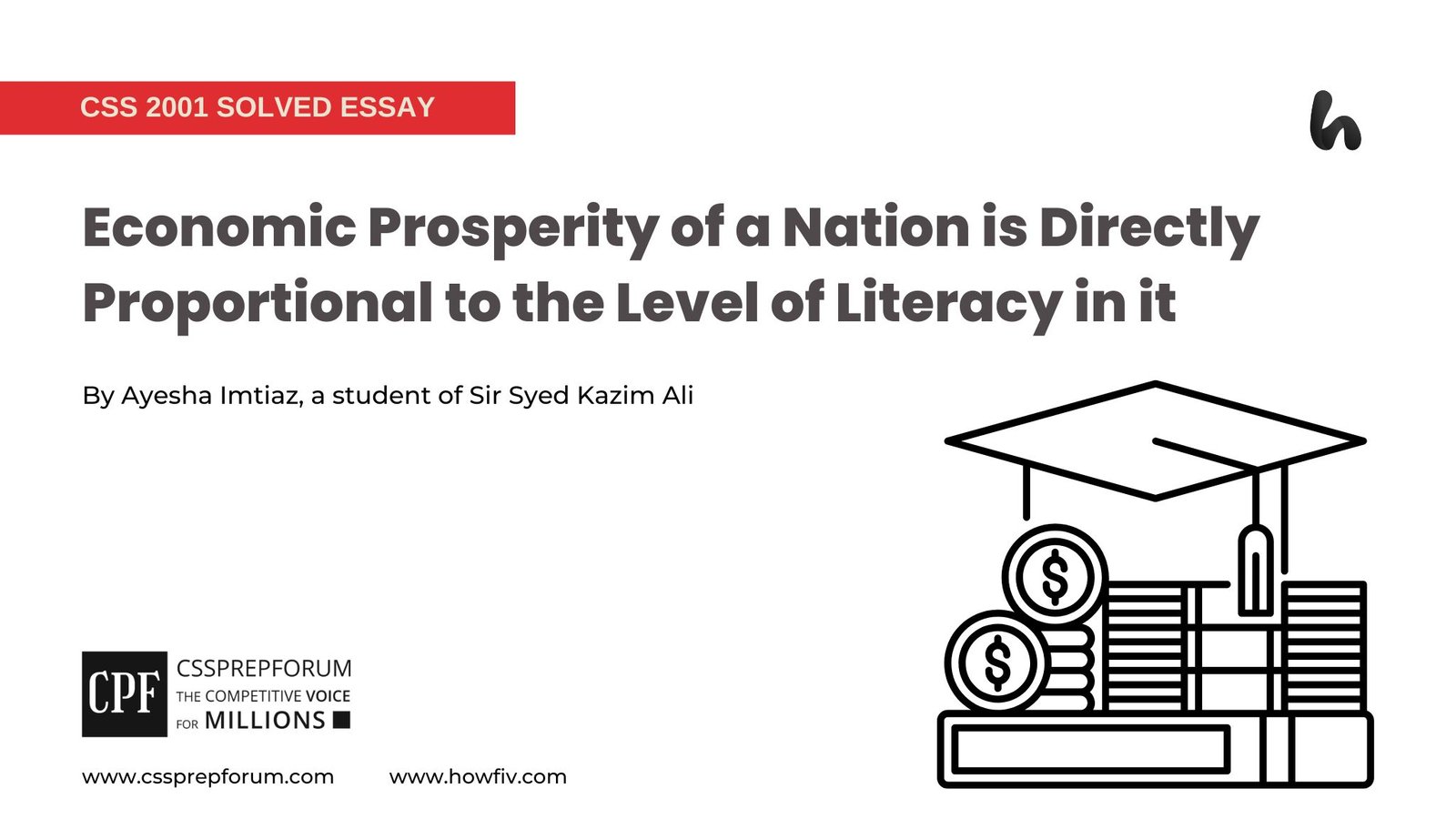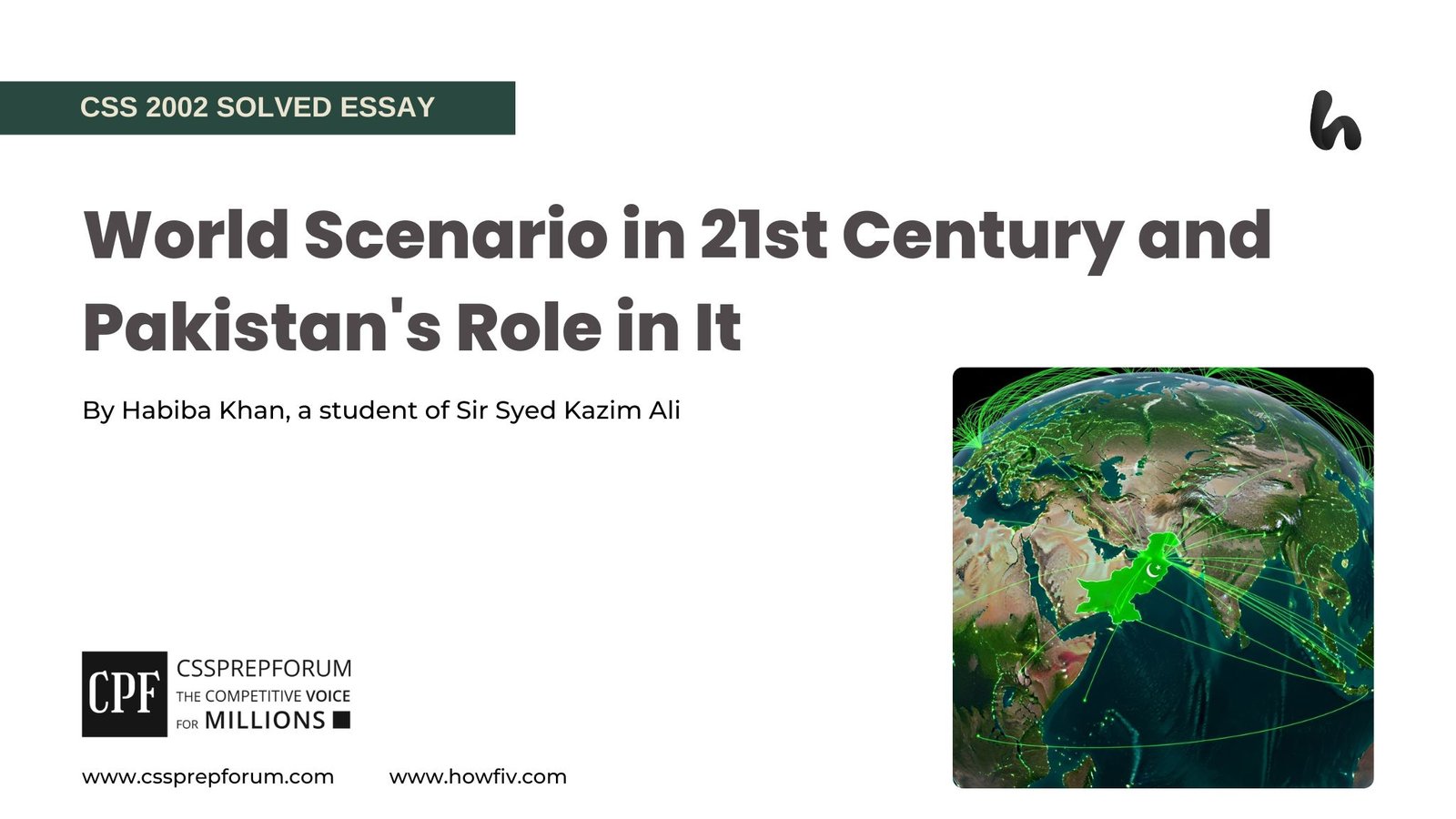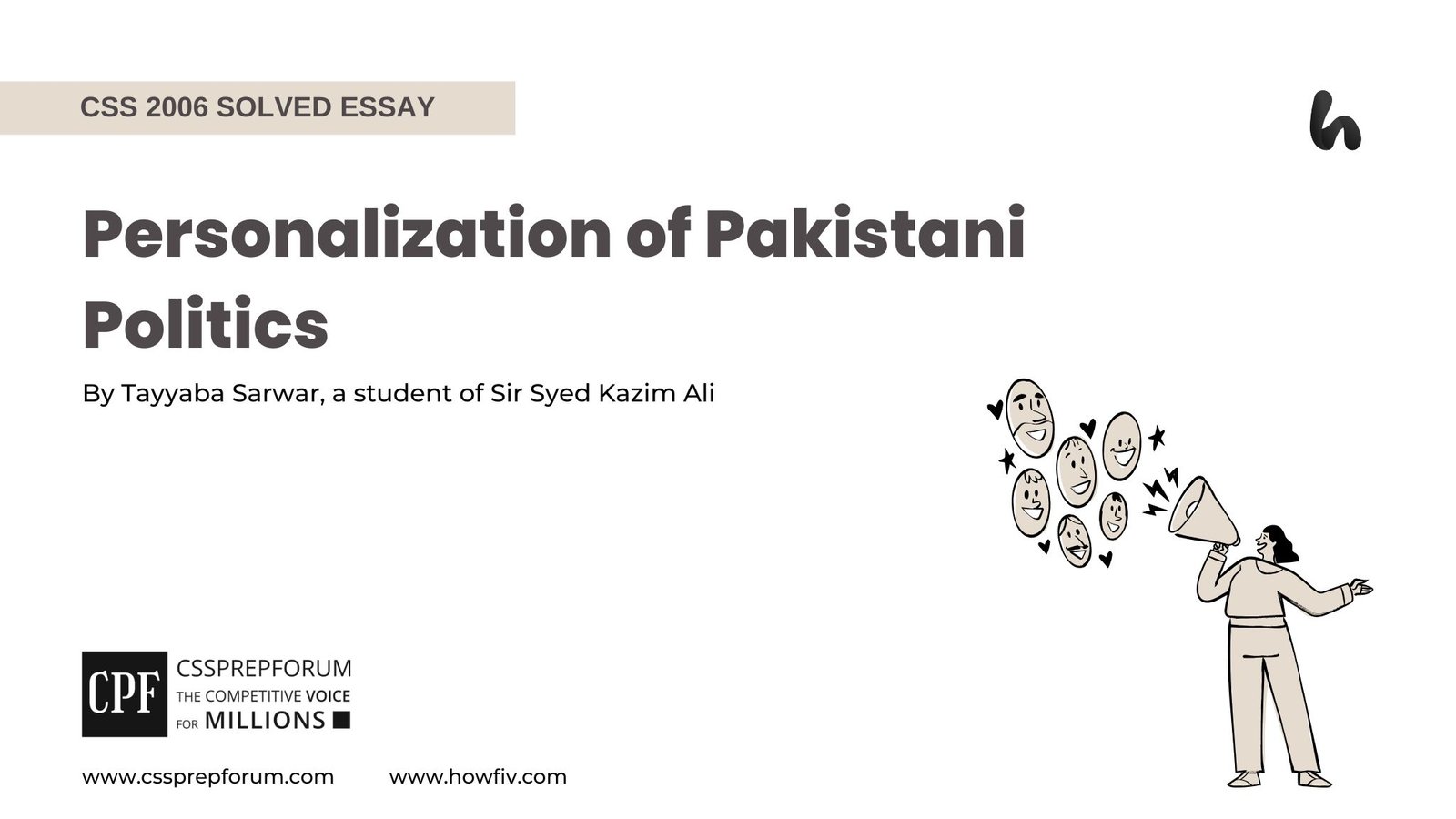CSS 2014 Solved Pakistan Affairs Past Papers | Population Explosion and the Economy of Pakistan
The following question of CSS Pakistan Affairs 2014 is solved by Miss Iqra Ali, the best Pakistan Affairs Coach, on the guided pattern of Sir Syed Kazim Ali, which he taught to his students, scoring the highest marks in compulsory subjects for years. This solved past paper question is uploaded to help aspirants understand how to crack a topic or question, how to write relevantly, what coherence is, and how to include and connect ideas, opinions, and suggestions to score the maximum.

Question Breakdown
In this question, examiner has asked an analytical discussion on how the rapid population growth in Pakistan poses significant challenges to its economy. To provide a comprehensive answer, begin with an introduction that contextualize the issue of population explosion in the country, included its current demographic trends and economic implications. Briefly mention how unchecked population growth impacts resources, infrastructure, and development. In the main body, focus on key aspects of the problem and then conclude the answer by critically analyzing the question.
Outline
1-Introduction
- ✓ Pakistan’s population growth rate continues to soar, outpacing resources and infrastructure, posing a direct threat to the country’s economic stability and sustainability.
- ✓ The burgeoning population challenges Pakistan’s ability to meet the growing demand for essential services such as healthcare, education, housing, and employment.
- ✓ Without immediate and strategic intervention, the population boom will deepen poverty, strain resources, and undermine long-term economic growth prospects.
2-Impacts of Population Explosion on Pakistan’s Economy
- ✓ Unsustainable Economic Growth
- Case in point; As population growth outpaces economic growth, the per capita income decreases, leading to widespread poverty. The gap between rich and poor widens, aggravating social inequality.
- Case in point; According to the State Bank of Pakistan, Public debt has soared to around 85% of GDP, largely due to the need to support a rapidly growing population.
- ✓ Escalating Unemployment Rates
- Case in point; According to International Labour Organization (ILO), As of 2023, Pakistan’s unemployment rate stands at around 6.3%, with a significant number of people unable to find jobs. This equates to over 5.6 million unemployed individuals, contributing to rising poverty levels.
- Case in point; Unemployment, in turn, contributes to a greater dependency on the state for welfare, draining public finances.
- ✓ Overburdened Public Services
- Case in point; The healthcare and education systems are already underfunded and overburdened, with population growth compounding existing challenges.
- Case in point; According to the World Health Organization (WHO), The healthcare system has been overwhelmed with a population-to-doctor ratio of 1:1,100.
- ✓ Food and Resource Scarcity
- Case in point; According to Pakistan Water Partnership, The country’s per capita water availability has decreased dramatically from 5,000 cubic meters in the 1950s to under 1,000 cubic meters today, classifying Pakistan as one of the most water-stressed countries.
- Case in point; Agriculture, which employs a large portion of the population, faces stagnation due to shrinking arable land, water scarcity, and environmental degradation, resulting in food insecurity.
- ✓ Environmental Degradation
- Case in point; According to the World Bank, Pakistan faces severe environmental challenges, costing the country around 6% of its GDP annually.
- Case in point; Increasing consumption, industrialization, and waste generation contribute to severe environmental challenges, such as water pollution and rising carbon emissions, undermining long-term economic viability.
- ✓ Hindrance to Sustainable Development
- Case in point; The strain on resources and public services diverts national attention from achieving critical goals such as poverty alleviation, education reform, healthcare improvement, and infrastructure development.
- Case in point; Population growth severely limits Pakistan’s ability to meet the United Nations Sustainable Development Goals (SDGs), particularly in areas related to hunger, health, gender equality, and decent work.
- ✓ Global Competitiveness in Decline
- Case in point; Overpopulation reduces labor productivity due to inefficiencies in the workforce and lack of opportunities for skilled development.
- Case in point; Pakistan lags behind in the global market in terms of innovation, technological advancement, and overall economic competitiveness.
3- What should be the pragmatic measures to control population explosion?
- ✓ To launch mass campaigns for education and awareness
- ✓ To encourage women’s empowerment and their participation in the workforce
- ✓ To expand access to affordable and Improved Healthcare Services
- ✓ To strengthen Family Planning Policies and ensure their effective implementation
- ✓ To introduce Economic Incentives for Small Families
- ✓ To enact and enforce legislative and social Reforms
4-Conclusion

Answer to the Question
Introduction
Pakistan is grappling with one of the most pressing issues of its time: an uncontrollable population explosion. The country’s rapid population growth, surpassing the capacity of its resources and infrastructure, poses a severe threat to its economic stability and sustainable development. With an annual population increase that seems relentless, the country faces immense challenges in providing adequate healthcare, education, housing, and employment opportunities for its citizens. Moreover, the strain on the nation’s public services, natural resources, and agricultural capacity is becoming increasingly evident, with repercussions that extend far beyond the immediate future. According to the Pakistan Economic Survey 2023, Pakistan’s per capita income has stagnated at around $1658 in 2023, largely due to disproportionate increase in population relative to economic growth. Henceforth, the escalating population has led to widespread unemployment, deepening poverty, and a sharp rise in social inequality. The situation is further compounded by environmental degradation, as the expanding population accelerates the depletion of resources and pollutes the ecosystem. In this context, the country’s ability to achieve long-term economic growth and fulfill its developmental goals is at risk. So that, addressing the population explosion is not merely a demographic challenge, but a critical economic and social imperative that demands urgent, multifaceted intervention.
Impacts of Population Explosion on Pakistan’s Economy
- Unsustainable Economic Growth
Meanwhile, the population explosion in the state is severely hindering its economic growth, making it increasingly unsustainable. Rapid population growth intensifies the demand for resources, jobs, and infrastructure, yet the economy struggles to meet these rising needs. As the labor force grows, job creation cannot keep pace, leading to high unemployment and underemployment, which stifle productivity. This imbalance results in stagnating per capita income and widening economic inequalities. According to the Ministry of Energy Pakistan, Pakistan faces an annual energy shortfall of approximately 5,000 MW, affecting industrial output and economic development. With public services such as healthcare, education, and housing becoming overwhelmed, their quality and accessibility diminish, further exacerbating socio-economic disparities. Furthermore, the growing population places immense pressure on the environment, accelerating resource depletion and environmental degradation, which in turn affects agriculture and industry. However, this unsustainable growth trajectory not only limits the country’s ability to harness its demographic potential but also undermines efforts to achieve long-term economic stability and prosperity. Without addressing the underlying factors of population growth, the country risks falling into a cycle of economic stagnation and increasing poverty.
- Escalating Unemployment Rates
Furthermore, the surging population in the state has triggered a dramatic rise in unemployment rates, creating a critical challenge for the nation’s economic stability. With a rapidly expanding labor force, the economy is unable to generate sufficient employment opportunities to absorb the growing number of job seekers. So, this mismatch between supply and demand in the job market has led to widespread joblessness, particularly among the youth, who make up a significant portion of the population. According to International Labour Organization (ILO), As of 2023, Pakistan’s unemployment rate stands at around 6.3%, with a significant number of people unable to find jobs. This equates to over 5.6 million unemployed individuals, contributing to rising poverty levels. Therefore, the lack of employment prospects not only fuels economic stagnation but also exacerbates poverty and social inequality, leaving many households struggling to meet their basic needs. Additionally, the rising unemployment rate has far-reaching consequences, including an increase in social unrest and a loss of human capital potential, as skilled and educated individuals remain underutilized. Similarly, the economic burden of unemployment also places additional strain on public resources, further hindering development efforts. Addressing this crisis requires strategic investments in education, vocational training, and job creation to unlock the potential of the workforce and foster sustainable economic growth.
- Overburdened Public Services
In the same context, the unchecked population growth in the country has placed an overwhelming burden on public services, crippling their ability to function effectively. Essential sectors such as healthcare, education, and housing are stretched to their limits, struggling to cater to the ever-increasing demand. Henceforth, hospitals face overcrowding, leaving countless patients without access to timely medical care, while educational institutions grapple with insufficient facilities, untrained staff, and rising dropout rates. According to the World Health Organization (WHO), The healthcare system has been overwhelmed with a population-to-doctor ratio of 1:1,100. Moreover, the strain on housing infrastructure has led to the proliferation of slums and inadequate living conditions, further compounding societal challenges. Unfortunately, this overextension of public services not only compromises their quality but also deepens disparities, leaving marginalized communities disproportionately affected. The government’s inability to expand and enhance these services at the same rate as population growth undermines human development and social stability. This crisis highlights the urgent need for efficient resource management, strategic planning, and investments to strengthen public service systems and ensure equitable access for all citizens, fostering a more resilient and balanced society.
- Food and Resource Scarcity
Similarly, the relentless population growth in the state has intensified food and resource scarcity, posing a serious threat to the nation’s stability and development. Agricultural production, already constrained by limited arable land and outdated practices, struggles to meet the soaring demand for food, resulting in rising prices and widespread food insecurity. Water resources, critical for both agriculture and human consumption, are depleting at an alarming rate due to overuse and mismanagement, further exacerbating the crisis. According to Pakistan Water Partnership, The country’s per capita water availability has decreased dramatically from 5,000 cubic meters in the 1950s to under 1,000 cubic meters today, classifying Pakistan as one of the most water-stressed countries. Subsequently, energy shortages have become commonplace, hindering industrial output and affecting daily life. This scarcity extends to essential commodities, with insufficient supply unable to sustain the growing population. Likewise, the imbalance between resource availability and demand heightens competition, disproportionately affecting vulnerable groups and deepening societal inequalities. Left unchecked, this resource crunch threatens to derail economic progress and worsen environmental degradation. Addressing these challenges requires immediate action, including modernizing agricultural practices, improving water conservation, and adopting sustainable resource management strategies to ensure food and resource security for future generations.
- Environmental Degradation
Furthermore, the rapid population growth in the country is accelerating environmental degradation, creating a cascade of ecological challenges that threaten the nation’s sustainability. The relentless demand for land, water, and energy has led to deforestation, soil erosion, and depletion of natural resources, disrupting delicate ecosystems. In addition to it, urban sprawl, driven by the expanding population, contributes to unregulated construction and waste generation, polluting air, water, and land at unprecedented levels. According to the World Bank, Pakistan faces severe environmental challenges, costing the country around 6% of its GDP annually. So that, industrial growth, while necessary for economic development, has intensified greenhouse gas emissions and toxic discharges, exacerbating climate change and public health issues. Later, the overuse of water resources for agriculture and urban needs has resulted in dwindling freshwater reserves and declining water quality. These environmental pressures not only compromise the health and livelihoods of millions but also hinder efforts to achieve sustainable development. Without immediate intervention to promote green technologies, enforce environmental regulations, and raise awareness about conservation, the state risks long-term ecological and economic instability, endangering the well-being of current and future generations.
- Hindrance to Sustainable Development
Henceforth, the population explosion in the state is widely regarded as the greatest threat to its economy due to its profound hindrance to sustainable development. The rapid increase in population outpaces the nation’s capacity to balance economic growth with environmental preservation, resource management, and societal needs. Overcrowded cities, inadequate infrastructure, and overburdened public services leave the economy struggling to accommodate this demographic surge. Meanwhile, The excessive strain on natural resources like water, energy, and agricultural land disrupts the equilibrium necessary for long-term economic stability. Additionally, the imbalance between the growing workforce and limited employment opportunities suppresses productivity and fuels poverty. According to UNESCO, Pakistan allocates only about 2.9% of GDP to education and 1.2% to healthcare, far below the global average, which hampers human capital development. As a result, this unchecked growth diverts resources from critical investments in education, healthcare, and technology, which are essential for innovation and modernization. The failure to achieve sustainable development not only weakens the economic foundation but also diminishes the nation’s ability to compete globally. Without decisive action to curb population growth and implement sustainable policies, the nation’s economic potential remains at grave risk.
- Global Competitiveness in Decline
However, the population explosion in the state is critically undermining its global competitiveness, making it a significant threat to the nation’s economy. With an unchecked demographic surge, resources are increasingly diverted toward meeting immediate domestic needs rather than fostering innovation, technological advancement, and industrial growth. Overburdened infrastructure, inadequate education systems, and limited access to quality healthcare leave the workforce underprepared to compete in global markets. Furthermore, the strain on natural resources and energy shortages reduces productivity, driving up production costs and deterring foreign investment. According to the Ministry of Energy Pakistan, Pakistan faces an annual energy shortfall of approximately 5,000 MW, affecting industrial output and economic development. The lack of focus on research and development, coupled with insufficient export diversification, weakens the country’s position in international trade, causing it to lag behind other emerging economies. Later, this decline in competitiveness isolates the state from global economic trends, limiting its ability to attract international partnerships and capitalize on global opportunities. Addressing these challenges requires strategic investments in education, skills development, and sustainable industries to elevate its standing in the global economy and secure long-term economic growth.
What should be the pragmatic measures to control population explosion?
Nevertheless, to effectively control population explosion in it, education and awareness, alongside women’s empowerment, are vital measures. Comprehensive education programs can enlighten communities about the economic and social repercussions of unchecked population growth, encouraging smaller, well-planned families. Furthermore, integrating population education into school curricula fosters long-term awareness, while community outreach campaigns can address cultural and religious sensitivities surrounding family planning. Women’s empowerment plays a transformative role in this effort; providing access to quality education enables women to make informed decisions about their reproductive health and future. Moreover, equipping women with economic opportunities reduces dependency, encourages delayed marriages, and lowers fertility rates. Access to healthcare and family planning services, coupled with a supportive policy framework, ensures that women can exercise their rights and contribute actively to national development. By prioritizing these strategies, it can curb population growth, enhance the quality of life, and achieve sustainable economic progress.
Certainly, controlling its population explosion requires a robust focus on improving healthcare services and strengthening family planning policies. Accessible and affordable healthcare ensures better maternal and child health, reducing the need for larger families as a safeguard against high mortality rates. Meanwhile, expanding the availability of reproductive health services, particularly in rural and underserved areas, empowers families to make informed decisions regarding childbirth. Strengthening family planning policies, in the meantime, is essential to provide effective contraceptive options and promote their use through awareness campaigns. Integrating family planning into primary healthcare ensures that these services become a seamless part of everyday medical care. Moreover, offering incentives for smaller families and addressing societal and cultural barriers to contraception use can significantly enhance policy effectiveness. So, collaborative efforts between the government, private sector, and community organizations are necessary to build trust and encourage widespread participation. By prioritizing these measures, it can create a sustainable framework to manage its population growth and mitigate the economic and social challenges it presents.
Equally, addressing the population explosion in the state requires the adoption of economic incentives for small families and comprehensive legislative and social reforms. Providing financial benefits, such as tax relief, subsidies, or conditional cash transfers, can motivate families to limit the number of children, making smaller families more economically viable. Simultaneously, legislative reforms must focus on promoting family planning and enforcing minimum age limits for marriage, ensuring that young individuals are not pushed into parenthood prematurely. Therefore, social reforms are equally critical, aiming to dismantle cultural stigmas and misconceptions surrounding contraception and family planning. Public campaigns, led by community leaders and influencers, can foster acceptance of smaller families as a norm. Strengthening legal protections for women’s rights, including access to education and employment, further supports this cause by empowering women to actively participate in family planning decisions. Similarly, a unified approach combining financial incentives, legal frameworks, and societal transformation can effectively curb population growth, paving the way for sustainable development and economic stability.
Conclusion
In conclusion, the population explosion in the state stands as a formidable challenge, straining the nation’s economic, social, and environmental frameworks. This unchecked growth has amplified unemployment, resource scarcity, and social instability, while hampering efforts for sustainable development and global competitiveness. However, the crisis is not insurmountable if addressed through pragmatic measures such as enhancing education, empowering women, improving healthcare, and implementing robust family planning policies. Meanwhile, economic incentives and legislative reforms further offer viable pathways to reshape societal norms and control demographic trends. By fostering a collective commitment among policymakers, communities, and individuals, it can transform its burgeoning population into a productive asset, ensuring a balanced approach to growth that secures long-term prosperity and stability. Lastly, immediate and sustained action is crucial to alleviate the pressures of population growth and unlock the nation’s full potential in the global arena.
CSS 2014 Solved Pakistan Affairs
CSS Solved Past Papers’ Essays
Looking for the last ten years of CSS and PMS Solved Essays and want to know how Sir Kazim’s students write and score the highest marks in the essays’ papers? Then, click on the CSS Solved Essays to start reading them.
CSS Solved Essays
CSS Solved General Science & Ability Past Papers
Want to read the last ten years’ General Science & Ability Solved Past Papers to learn how to attempt them and to score high? Let’s click on the link below to read them all freely. All past papers have been solved by Pakistan’s top CSS GSA coach having the highest score of their students.
General Science & Ability Solved Past Papers












